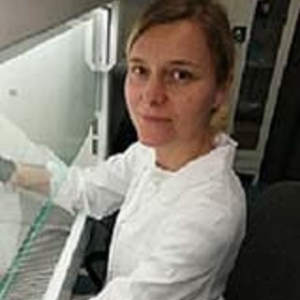Title : THE EFFECT OF ?-LINOLENIC ACID ON SECRETORY ACTIVITY OF ASTROCYTES AND ?-AMYLOID-ASSOCIATED NEURODEGENERATION PROCESS IN CO-CULTURE CONDITIONS
Abstract:
Alzheimer's disease (AD) is believed to contribute to 60–70% of neurodegenerative dementia cases. The pathogenesis of AD is associated with increased oxidative stress and inflammatory response. Neurons are particularly sensitive to oxidative disturbances caused by increased oxygen metabolism as well as low levels of antioxidants. Proper neuronal functioning is completely dependent on mitochondrial oxidative phosphorylation. It appears, that loss of mitochondrial membrane potential (ΔΨm), mutations in mitochondrial DNA, structural abnormalities, or uncontrolled inactivation of proteins regulating mitochondrial biogenesis (mitochondrial transcription factor A-mtTFA, mitofusin 2-Mfn2) can lead to disturbance of mitophagy (a type of autophagy removing dysfunctional mitochondria) and development of neurodegenerative diseases. The current research direction concerns the identification of factors and endogenous mechanisms that protect neurons from the toxic effects of Aβ. It is suggested that activation of the insulin and/or IGF-I signaling pathways may protect neurons from toxic effects of Aβ. Regulation of Aβ levels by glial cells may be another protective mechanism. In our study we focused on astrocytes, because astrocytes constitute the main source of growth factors in the CNS and play major roles in neuronal survival and maturation, precursor proliferation, and neuronal circuitry formation.
The aim of our study was to investigate the protective effect of α-linolenic acid (ALA) on β-amyloid-induced (Aβ) neurodegeneration in SH-SY5Y neuronal cells. We also examined whether ALA stimulates astrocytes to secretion of growth factors: insulin and IGF-I. Moreover, we would like to explore the interactions between neurons and ALA-induced astrocytes.
In our studies we used two cell lines: human astrocytes (NHA) and human neuroblastoma (SH-SY5Y). In the first step, we examined the effects of ALA [10, 50, 100, 250 nM] on NHA cell viability, insulin and IGF-I release. Next, we studied the preventive effects of astrocyte-conditioned medium (ACM) on Aβ1-42-treated SH-SY5Y cell viability, lactate dehydrogenase (LDH) release, mitochondrial membrane potential and expression levels of genes involved in mitophagy (PINK-1, Parkin), autophagy (ATG5, LC3β), mitochondrial biogenesis (mtTFA) and mitochondrial fusion (Mfn2, OPA1).
Treatment of 10nM ALA resulted in enhancing the NHA cell viability (p<0.02), insulin (p<0.001) and IGF-I (p<0.05) release. We also observed that Aβ1-42 treatment decreased the SH-SY5Y cell viability (p<0.0001), ΔΨm (p<0.05) and increased LDH release (p<0.001). Furthermore, Aβ1-42 treatment increased mRNA expression of PINK-1 (p<0.001), Parkin (p<0.001), ATG5 (p<0.05) and LC3β (p<0.001), while significantly reduced mRNA expression of mtTFA (p<0.01); OPA1 (p<0.001) and Mfn2 (p<0.05). Interestingly, ACM pre-treatment significantly reversed the effects of Aβ1-42 on SH-SY5Y cells viability, mitochondrial biogenesis, fusion machinery, mitophagy and autophagy. Additionally, incubation with ALA intensified the effects of ACM on SH-SY5Y cells viability (p<0.001), ΔΨm (p<0.05), mitochondrial function, and effectively reduced the Aβ1-42-induced LDH release (p<0.001). Our results suggest that the neuroprotective effect of ALA may be associated with stimulation of insulin and IGF-I secretion from astrocyte cells. Further, the protective effect of ACM on Aβ1-42-induced neurodegeneration in SH-SY5Y cells, is manifested by reduced mitochondrial dysfunction, and maintained cell viability, mitochondrial dynamics and mitochondrial biogenesis.




